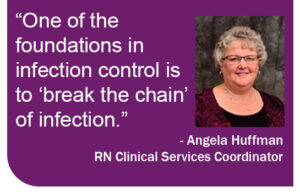By Angela Huffman, RN Clinical Services Coordinator
In early March 2020, as news began to emerge about the coronavirus, we immediately began to review and update our infection control policies and procedures. Throughout the pandemic, several infection control mitigation strategies were implemented to moderate and reduce the spread of coronavirus, including:
- Hand hygiene
- Physical Distancing
 Visitation, Activity and Dining restrictions
Visitation, Activity and Dining restrictions- Universal Masking
- Increased Cleaning and Disinfection
- Use of Transmission Based Precautions
- Proper use of Personal Protective equipment
- Cohorting strategies
- Screening and Testing Protocols
- COVID vaccination
Although these practices have been the core focus in the news media and regulatory guidance, cleaning and disinfection protocols have been a mainstay in healthcare for years, dating back to the mid-1800s.
Germs are a part of everyday life, inside and outside of the healthcare setting. Some germs are helpful, but others can be harmful and can cause disease. Germs are found everywhere – in our air, soil, water and on the surfaces and objects that we touch. Germs live on our skin and in our bodies. There are times when germs can spread and cause illness.
One of the foundations in infection control is to “break the chain” of infection. Despite the variety of viruses and bacteria, germs are spread from person to person through a common series of events. To be successful in breaking a link in the chain, we must find ways to stop germs from spreading and infecting more people.
To avoid becoming infected by germs from surfaces and objects, it is important that we not only wash or sanitize our hands, but also clean and disinfect the surfaces and objects around us. Cleaning and disinfection of the environment is just one of several ways that the chain can be broken to prevent the spread of germs. The history of cleaning and disinfection dates back to 5000 B.C., when the ancient Egyptians used wine or vinegar to clean and whiten clothing. It was not until the 1600s that scientists began to learn chemicals could potentially kill unseen organisms, opening the door to the study and use of chemicals to kill germs.
There are key differences between cleaning, disinfecting and sanitizing. The two major ways to protect ourselves during the COVID-19 pandemic have been washing/sanitizing our hands and cleaning/disinfecting commonly touched surfaces. The process seems basic and self-explanatory until you are trying to decide on which products to use.
While sanitizers and disinfectants are often used interchangeably, they are very different and have varied uses. According to the Centers for Disease Control (CDC), cleaning, sanitizing and disinfecting all have different definitions:
- Cleaning “removes germs, dirt and impurities from surfaces buy scrubbing, washing and rinsing. Cleaning does not kill germs, but by removing them it lowers their numbers and reduces the risk of spreading infection.”
- Sanitizing refers to using “chemicals to kill germs on surfaces, reducing bacteria on a surface or an object to a safe acceptable level; but does not kill everything.”
- Disinfecting “destroys or inactivates both the bacteria and viruses on hard, non-porous surfaces.”
Disinfectants are stronger than sanitizers and can kill 99.999% of germs and are one of the most reliable ways to help lower the risk of spreading germs from surfaces by touch. Disinfectants, such as bleach or a EPA-approved product, are the only products approved to kill both bacteria and viruses on hard surfaces. Reading product labels is essential to understand what the product is used for and how to apply the product. The chemicals being utilized in our communities are EPA approved and are effective against the Coronavirus.
As part of the battle against COVID, our communities have added innovative products. Electrostatic sprayers dispense a fine mist disinfectant to high-touch surfaces that add a protective layer. Portable air filtration with ultraviolet light (UVC) is used to capture and kill airborne pathogens and eliminate bacteria, mold and odor circulating in the air. Providing a safe and sanitary environment for our staff, families and residents remains our primary focus and priority. We remain diligent and steadfast in our efforts to clean, sanitize and disinfect our communities to “break the chain” to move one step closer toward winning the battle against COVID-19.
Be well and stay safe.

